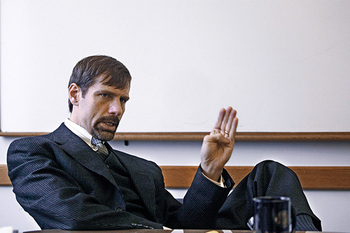Today we’re going to talk about something a little more unusual!
No, we won’t be talking about crop circles. However, we are going to talk about a phenomenon that is just as rare but also just as impressive, and most definitely not a hoax:
Female speakers.
Many top public speakers seem to be male – and indeed, they are. If there are any feminists in the audience, hold the rotten eggs – I’m not saying that there aren’t any top female speakers, but it could also be because there are still less women than men in top positions of power or leadership, although the gap is closing.
But never fear: here are a few good examples of good female speakers – a politician, an academic, and a professional speaker. We’ll take a look three main things that each of them got right and what you as speakers (men too!) can emulate.
Hillary Clinton
She was in the running to be the President of the United States. Even now, she’s a potent force in US politics. Here’s a clip from her Texas debate with Obama.
Appearance:
She’s gotten a lot of flak over her appearance – heckled by journalists asking who does her hair, people whining that her pantsuits were too masculine, etc. But that’s because she’s a politician on the campaign trail, and anything is open to fire.
If you aren’t a politician, she’s actually a pretty good role model for how to dress to impress. I like this outfit – a black jacket but with a touch of color at the collar and the hems of her sleeves, which is professional without being too boring or severe.
Also, bling distracts your audience. So if you accessorize, be simple, like that plain gold band around her neck. Large, dangling earrings are the biggest culprits.
Use of anecdote:
Her story about the center for wounded soldiers is definitely a good use of anecdote. It plays to her audience’s nationalist sympathies while demonstrating her humility. Besides that, it gets in a good dig at her opponent when she says that she and McCain were invited as the ‘only two elected officials’.
Emotive language:
Most politicians do it, but I think she managed it particularly well here. Certainly well enough for her audience to give her a standing ovation. Her appeal to the concepts of ‘family and friends’ and her hope that every American person can have that are very personal in her context (‘I did not have sexual relations with that woman’, anyone?) and are brought across without sounding too rehearsed.
Helen Fisher
This lady isn’t quite as well known, so, a quick rundown: she’s an anthropologist who specializes in love: on the study of the sociological and scientific processes of love. An academic at Rutgers University, she is widely considered the leading expert on the topic.
Here, she delivers an intriguing 20-minute lecture on the effects of love on the brain, and weighs in on the social trends of women in the workforce and the aging population. And her public speaking style certainly doesn’t hurt her already interesting topic.
Appearance:
She fits the academic image perfectly. The black-framed glasses give her a scholarly air, and the black turtleneck and pants are relaxed without being too casual. Black adds a degree of seriousness, so while she isn’t intimidating, she doesn’t look intimidated either.
Tone:
Her speaking style suits the presentation well – it’s informative, but her variations in tone keep it from being dry.
She maintains a basic casual air throughout the whole presentation and inserts some droll moments of humor through tone of voice. For instance, she dryly quotes George Bernard Shaw, who said that love was overestimating the difference between one woman and another, garnering a delighted laugh from her audience.
These are examples of humor that is not rip-roaring laughter but is equally effective at keeping your presentation lighthearted and engaging. They are well balanced with moments when she is entirely serious, such as when she describes love not as a series of emotions but as a drive in certain centers of the brain.
Voice:
Women’s voices are naturally pitched higher than men’s are. Which means that if a woman’s speaks fast, it’s more difficult to hear her than if a man speaks faster. Also, higher voices have a higher chance of sounding shrill. So be careful.
Fisher has a good alto speaking voice – well-modulated and pleasant to listen to. Besides this, she keeps it firm and enunciates her words clearly and slowly, which will help a great deal in speech clarity.
Patricia Fripp
As an award-winning, internationally renowned speaker and speech coach, Patricia Fripp has been in the business of public speaking for several decades now. This clip is from her keynote address at Toastmaster’s International.
Energy level:
Fripp starts talking the moment she walks out of the wings, without waiting to get to centerstage. It shows how much enthusiasm she has, and it surprises the audience and energizes them too, because energy is infectious.
Besides that, she moves around when she talks, utilizing the whole stage rather than simply standing in one spot. Movement also ensures that the audience’s eyes are following you rather than fixed on one point, which again helps keep them awake.
Gesture:
Fripp uses a whole range of gestures to punctuate her words and gestures. Throughout the speech, she is never still, but neither is she too theatrical. Rather, simple hand movements (such as the forceful side-to-side movement to emphasize the words ‘do not’) make her point best.
Because she’s constantly on the move, the gestures are natural. If you spend most of your time speaking and only make isolated moves every so often, you risk the gesture look stiff and rehearsed, especially if you’re nervous.
That being said, do not fidget. If you want to be constantly moving, as Fripp does, make sure each movement is intentional.
Structure:
Fripp herself mentions this: structure and content are absolutely essential to public speaking. The lack of a structure means that you’re not sure what you want to say, and if you’re not sure what message you’re sending out, there’s no chance that your audience is going to get it.
Fripp’s structure:
Introduction -> three main points: structure, content, style -> elaborate on each -> conclude
It’s foolproof, and definitely worth sticking to if you’re not sure of yourself.
*
There are plenty of challenges that are specific to women, and even with the general concerns, women may have to interpret some aspects in a very specific manner. If you want more tips specific to women, here’s a possible resource:
The Woman’s Public Speaking Handbook (Paperback), by y Elizabeth J. Natalle (Author), Fritzi R. Bodenheimer (Author)
![]() Eric Feng is the go-to guy if you want to learn how to impress your investors and customers through public speaking. For more tips and tactics that you can use immediately in your next presentation, visit The Public Speaking Blog.
Eric Feng is the go-to guy if you want to learn how to impress your investors and customers through public speaking. For more tips and tactics that you can use immediately in your next presentation, visit The Public Speaking Blog.


